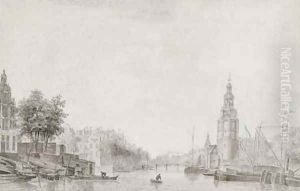Pieter Van Liender Paintings
Pieter van Liender was a Dutch artist who specialized in landscape drawings and paintings. He was born in 1726 in Amsterdam, where he spent most of his life and where he eventually died in 1772. His work belongs to the 18th-century Dutch artistic tradition, which was characterized by a high degree of skill in depicting naturalistic landscapes and cityscapes.
Van Liender's family was involved in the art world, which likely influenced his decision to pursue a career in art. His father, Paulus van Liender, was an engraver and draftsman, and his brother, Jan van Liender, was also an artist. Pieter's early training and artistic development are not well-documented, but it is presumed that he received instruction from his father, and possibly other local artists in Amsterdam.
During his career, Pieter van Liender produced a number of drawings and paintings that captured the Dutch countryside, often with an attention to detail that reflected the precision of his father's engraving work. His landscapes were typically composed with a sense of tranquility and order that was characteristic of Dutch landscape art of the time. He was particularly adept at using various techniques to depict different textures and elements of nature such as water, trees, and skies.
Van Liender's works were appreciated for their clarity and the serene quality they conveyed. He was part of a larger movement of Dutch artists who were moving away from the grand, dramatic landscapes of earlier periods and instead focusing on more intimate, peaceful scenes that could evoke a contemplative response from the viewer.
Not much is known about his personal life or his standing in the art world of his time. However, his surviving works suggest that he was a competent artist who contributed to the landscape genre in the Netherlands. The lack of extensive records on Van Liender's life and work is not uncommon for artists of his time, particularly those who did not attain the highest levels of fame or notoriety.
Pieter van Liender passed away in 1772, and while he may not have been as well-known as some of his contemporaries, his works remain as a representation of the artistic values and techniques of Dutch landscape painting in the 18th century. His drawings and paintings continue to be studied and appreciated for their technical proficiency and the quiet beauty they capture.
